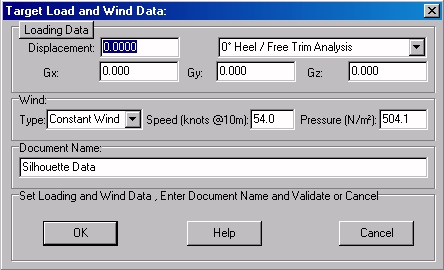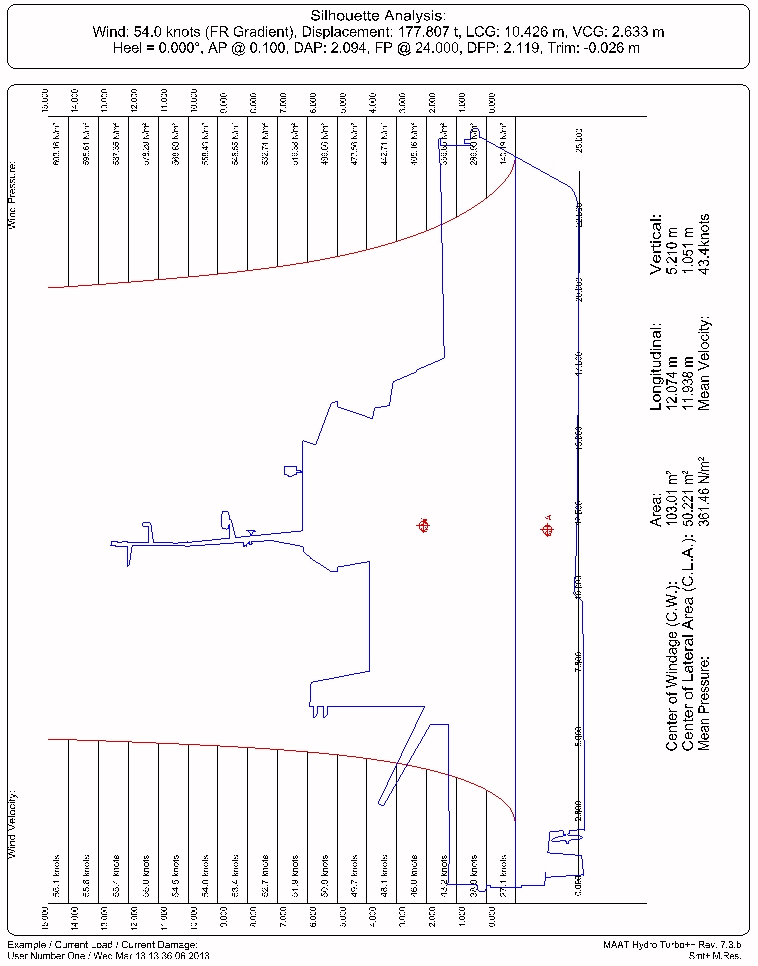Go to Help Summary Go to FAQ Summary
Menu bar/Tools/Silhouette Analysis
____________________________________________________________________________________________________________________
Purpose:
Calculates current ship’s silhouette data (i.e. windage and lateral plane data) for a given load (i.e. displacement and centre of gravity) for ship's equilibrium floatation for a free or 0° heel angle (keep in mind that no equilibrium can be found when transverse / longitudinal GM is negative or displacement exceeds ship’s buoyancy).
Inputs:
The following dialog box pops up when the function is selected:
The upper [Loading Data] button allows resetting the displacement and CG coordinates to their current values, corresponding to the present masses and /or liquids in the tanks (.
The target displacement can also be specified in the ‘Displacement’ field and C.G.’s coordinates in the ‘Gx’, ‘Gy’, ‘Gz’ fields.
The upper right selector allows selecting whether ship's equilibrium will be calculated for a free or a 0° heel angle.
The ‘Wind’ frame allows defining the wind characteristics to be used for silhouette integration:
- The ‘Type’ selector allows selecting the wind gradient:
- 'No Wind' for a constant 0 knot wind.
- 'Constant' for a constant wind velocity according to Z
- 'FR' for a French variable gradient.
- 'US' for a US variable gradient.
Silhouette’s vertical center of windage is usually higher for a variable gradient than for a constant one, as the wind velocity increases according to Z.
- The ‘Speed (knots @ 10m) field allows defining wind’s speed in knots at z = 10 m. The corresponding unitary pressure is updated in real time according to gradient’s associated density.
- The ‘Pressure (N/m²)‘ field allows defining wind’s unitary pressure. The corresponding speed is updated in real time according to gradient’s associated density.
At last, when all these floatation data are set, the input field located in the ‘Document Name’ frame will allow naming the created hydrostatic report among the 2D data listed in the 2D browser if necessary and, finally:
The [OK] button can be clicked for calculating ship’s data and creating the corresponding report.
The [Help] button allows displaying the online help (Internet access necessary).
The [Cancel] button allows cancelling the calculation.
Outputs:
After clicking on the [OK] button, an hydrostatic report corresponding to the entered data is created and displayed in the [2D] tab:
Limitations:
This report can only be obtained when one or more silhouette descriptors (i.e. outlines or closed lines in the ‘Silhouette Layer’ selected on [Ship] tab’s [Hydro] page) are included in the current ship model. It is hereby recalled that holes in the silhouette outline can be represented by affiliating their corresponding outline to the outer silhouette outline by dragging and dropping it in the 3D browser.
- At least one solid must be present to allow any buoyancy calculation.
- Displacement must not exceed ship’s buoyancy and induce a negative GMs.
Typical use:
Calculating ship’s silhouette properties, in its current status, for given load and wind.
Example:
Open the ‘Example Ship.m2a’ file and double click on ‘Damage 100% Supply’ in the 3D browser to select this virtual ship:
- Select "/Tools/Floatation Analysis/Silhouette Analysis" in the menu bar.
- Click on the [Loading Data] button to reset the loading Data (i.e. displacement and C.G.’s position) to their current value.
- Select a [US] wind gradient in the ‘Type’ selector.
- Set a 50 knots velocity in the corresponding field (see the unitary pressure changes).
- Click on the [OK] button directly to calculate ship’s equilibrium floatation and hydrostatic data: The corresponding report will be created and displayed among the 2D data.
- Repeat this example for a constant gradient and compare the obtained heights of the center of windage (VCW).
You can exit the 2D display page by clicking the [Ship], [3D] or [Data] tab.


